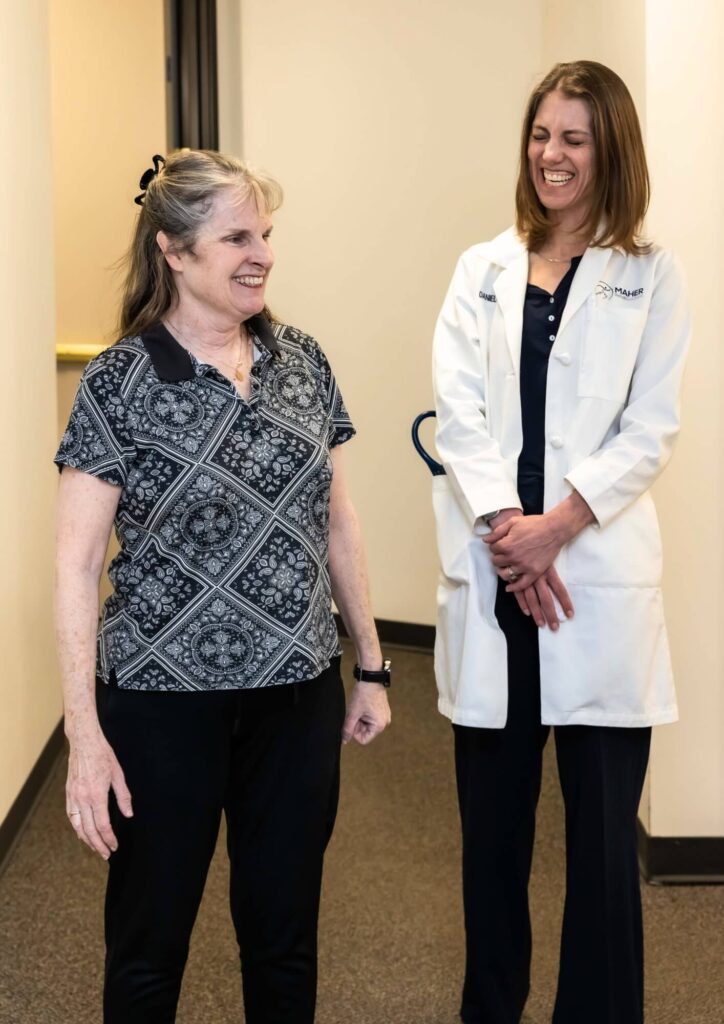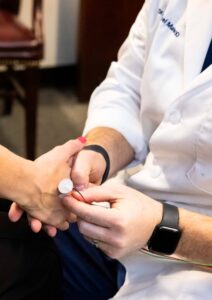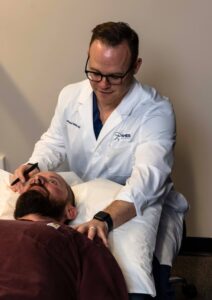Patient Resources
Find everything you need to navigate your care with ease. From insurance and payment details to educational materials and forms, we provide the resources to support you at every step.
Forms and Documents
Frequently Asked Questions
What happens after I am referred?
Once we receive your referral form we will reach out to confirm the details. Next, we reach out to schedule your appointment and provide you with the New Patient Paperwork. Before your visit, we will also confirm your payment method, which may include cash, lien pay, Med Pay, or workers’ compensation.
Why was I referred to Maher Rehab Solutions?
Your doctor or medical provider may have referred you for specialized evaluation and treatment. If you were involved in an accident, your law firm may have requested an evaluation to assist with your case.
What type of doctors are at your clinic?
Our clinic is staffed by board-certified medical providers specializing in physical medicine and rehabilitation (PM&R). Physiatrists diagnose, treat, and rehabilitate patients experiencing temporary or permanent physical impairments or pain that impact daily function, quality of life, and overall well-being.
How does your team support my care?
Think of us as the quarterback of your care team—we coordinate with medical providers, legal professionals, and rehabilitation specialists to bring together the right experts for your recovery.
Our goal is to develop a comprehensive treatment plan that supports pain management, rehabilitation, and long-term well-being. If controlled substances are part of your treatment, specific medical and legal requirements will apply.
When will my appointment be scheduled?
Appointment scheduling depends on your specific care plan and medical needs. Most patients are scheduled within 2 weeks after the initial referral if not faster, while others may wait 3 to 4 months, depending on the complexity of care.
If controlled substances are part of your treatment, our policy requires that you be seen at least once every three months to continue receiving prescriptions. Failure to attend required appointments may result in suspension of medication.
Key Policies & Patient Responsibilities
We are committed to providing transparent, high-quality care. Below are important policies regarding appointments, payments, and medical-legal agreements to ensure a smooth experience for our patients.
No-Show & Late Cancellation Policy
We understand that schedules change, but we ask that patients provide at least 24 hours’notice for cancellations. Failure to cancel in advance will result in a no-show fee.
- $75 for self-pay patients
-
$300 for patients with a lien or motor vehicle case
Patients who miss three consecutive appointments without proper notice may be discharged from care.
Billing & Payment Policy
- We file claims as a courtesy, but patients are responsible for verifying insurance coverage and ensuring any required pre-authorizations are in place.
- Co-pays, co-insurance, and deductibles must be paid before appointments.
- Any insurance denials or unpaid balances will be the patient's responsibility.



Medical-Legal Agreement & Lien Policy
If your treatment is related to a personal injury case, a Health-Care Provider’s Lien Agreement is required to ensure that payment is made from your final settlement, judgment, or verdict.
- This agreement allows Maher Rehab Solutions to provide necessary care while awaiting case resolution.
- Patients must notify our office immediately if their legal case status changes.
For full details, please review and complete the Health-Care Provider Lien Agreement before your visit.
In-Patient and Exam Room Procedures
As a facility specializing in physical medicine and rehabilitation, we primarily treat orthopedic and neurological conditions, along with some rheumatological cases. Our procedures are divided into diagnostic studies and therapeutic treatments to assess and manage various musculoskeletal and nerve-related issues.
For our diagnostic studies, we utilize:
- Ultrasound to assess orthopedic conditions involving muscles, bones, tendons, and ligaments.
- Electrodiagnostic studies, including nerve conduction studies and electromyography (EMG), to evaluate nerve health and diagnose conditions such as radiculopathy (pinched nerves), brachial and lumbosacral plexus injuries, and carpal tunnel syndrome.
These studies help guide treatment decisions, including whether surgery is necessary.
For our therapeutic treatments, we provide:
- Joint injections (e.g., knee, shoulder, and hip) using ultrasound if needed for conditions like osteoarthritis.
- Trigger point injections for persistent muscle knots in the neck or lower back when other treatments like physical therapy and massage have failed.
- Botox injections for medical conditions such as spasmodic torticollis (severe neck muscle tightness), migraines, and spasticity management—not for cosmetic purposes.
While we don’t perform surgeries, we offer a range of minimally invasive treatments to relieve pain and improve function for our patients.
Common Physical Examinations
We perform detailed physical examinations to diagnose and assess neurological and orthopedic ailments. We keep our process systematic and consistent, ensuring accurate diagnosis and treatment planning.
Neurological
Examination
- Reflex Testing – Uses a reflex hammer to check nerve responses, ensuring proper function.
- Sensory Testing – Assesses sensation differences between the left and right sides to detect nerve dysfunction.
- Motor Strength Testing – Evaluates leg and foot strength through resistance exercises, comparing both sides for symmetry.
- Neural Tension Tests (Sciatica Testing) – Uses a sit slump maneuver to assess sciatic nerve involvement by positioning the spine and legs to reproduce symptoms.
Hip
Examination
- Straight Leg Raise Test – Identifies nerve irritation or dysfunction by passively lifting the leg.
- Passive Range of Motion Tests – Assesses hip flexibility and pain response when manually moving the leg.
- Intra-Articular Maneuvers (Inside the Hip Joint) – Evaluates pain and mobility by applying pressure inside the hip joint.
- Extra-Articular Testing (Outside the Hip Joint) – Examines structures such as the IT band, gluteal muscles, and the greater trochanter for inflammation or dysfunction.
Low Back
Examination
- Palpation of the Quadratus Lumborum Muscle – Checks for tightness or inflammation, a common issue in patients with hip pain.
- Trigger Point Identification – Locates muscle knots and tension that may require trigger point injections for relief.
Treatment
Considerations
- Steroid injections for inflamed bursae near the hip joint to reduce pain and inflammation.
- Trigger point injections for deep muscle tightness in the lower back, which may not respond well to massage or physical therapy alone.
- Complementary therapies such as chiropractic care, physical therapy, and massage therapy to enhance recovery, particularly when used alongside injections at the right stage of treatment.
Neurological
Examination
- Reflex Testing – Uses a reflex hammer to check nerve responses, ensuring proper function.
- Sensory Testing – Assesses sensation differences between the left and right sides to detect nerve dysfunction.
- Motor Strength Testing – Evaluates leg and foot strength through resistance exercises, comparing both sides for symmetry.
- Neural Tension Tests (Sciatica Testing) – Uses a sit slump maneuver to assess sciatic nerve involvement by positioning the spine and legs to reproduce symptoms.
Hip
Examination
- Straight Leg Raise Test – Identifies nerve irritation or dysfunction by passively lifting the leg.
- Passive Range of Motion Tests – Assesses hip flexibility and pain response when manually moving the leg.
- Intra-Articular Maneuvers (Inside the Hip Joint) – Evaluates pain and mobility by applying pressure inside the hip joint.
- Extra-Articular Testing (Outside the Hip Joint) – Examines structures such as the IT band, gluteal muscles, and the greater trochanter for inflammation or dysfunction.
Low Back
Examination
- Palpation of the Quadratus Lumborum Muscle – Checks for tightness or inflammation, a common issue in patients with hip pain.
- Trigger Point Identification – Locates muscle knots and tension that may require trigger point injections for relief.
Treatment
Considerations
- Steroid injections for inflamed bursae near the hip joint to reduce pain and inflammation.
- Trigger point injections for deep muscle tightness in the lower back, which may not respond well to massage or physical therapy alone.
- Complementary therapies such as chiropractic care, physical therapy, and massage therapy to enhance recovery, particularly when used alongside injections at the right stage of treatment.
We offer a comprehensive, patient-centered approach, ensuring that each examination leads to precise diagnosis and effective, minimally invasive treatment for long-term relief.
